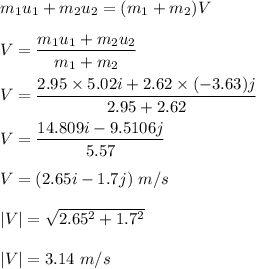
Physics, 24.03.2020 05:14 kkartes753
An object of mass 2.95 kg, moving with an initial velocity of 5.02 i hat m/s, collides with and sticks to an object of mass 2.62 kg with an initial velocity of -3.63 j m/s. Find the final velocity of the composite object.

Answers: 2


Other questions on the subject: Physics

Physics, 21.06.2019 21:30, ddoherty88
Aquantity of gas has a volume of 1.5 m3 and an absolute pressure of 95 kpa. when the gas is compressed to a volume of 0.5 m3, what is the new absolute pressure of the gas? (assume that there’s no change in temperature.)
Answers: 3

Physics, 22.06.2019 00:20, glogaming16
In the derivation of rrkm theory, a factor of 1/2 is introduced when equalizing the rates of formation and decomposition of activated complex as keal-hr) = ko this is clearly against the assumption of transition state theory that states all the activated complex in the transition state iss going to the product. find the reason why this factor is introduced here.
Answers: 2

Physics, 22.06.2019 06:00, nelsy7610
Suppose water is leaking from a tank through a circular hole of area ah at its bottom. when water leaks through a hole, friction and contraction of the stream near the hole reduce the volume of water leaving the tank per second to cah 2gh , where c (0 < c < 1) is an empirical constant. a tank in the form of a right-circular cone standing on end, vertex down, is leaking water through a circular hole in its bottom. (assume the removed apex of the cone is of negligible height and volume.) (a) suppose the tank is 20 feet high and has radius 8 feet and the circular hole has radius 2 inches. the differential equation governing the height h in feet of water leaking from a tank after t seconds is dh dt = − 5 6h3/2 . if the height of the water is initially 8 feet, how long will it take the tank to empty? (round your answer to two decimal places.)
Answers: 2

Physics, 22.06.2019 13:50, highlander4215
Observations show that interstellar clouds can have almost any shape and
Answers: 1
You know the right answer?
An object of mass 2.95 kg, moving with an initial velocity of 5.02 i hat m/s, collides with and stic...
Questions in other subjects:










Mathematics, 18.06.2020 01:57








